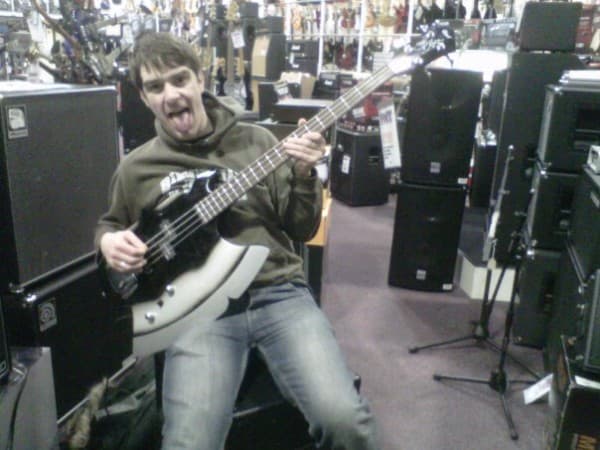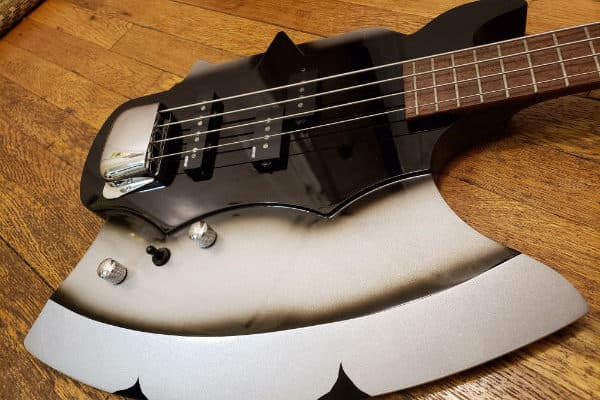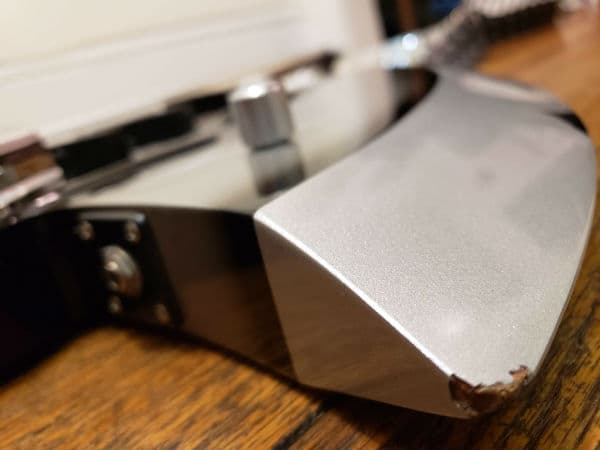The axe bass is an eye-catching piece of gear, that’s for sure. Signature models and unusual instrument designs come under a lot more scrutiny overall as an instrument. So what happens when an instrument is both?
After recording drums in my last post, and with bass up next in terms of recording, I thought it would be useful to look at what I use.
Background
I’m not old enough to have been a fan when KISS were originally big. The specifics of how I got into them have been lost in time. It might have been seeing Paul Stanley’s cracked mirror signature model in a Guitar World catalog. I remember getting Psycho Circus on CD when I was 15 or 16.
Musicians of my era – the 90s – looked like they could’ve been anybody. KISS was a dramatic break from that. I loved the theatricality and spectacle of it all, right down to their instruments.
I was certainly aware of the axe bass. No more than the rest of… anything to do with KISS… it looked fun!
In 2012, a local music store in Birmingham posted on their Facebook page that they had a used one. I had a little money to spare, and bought it the following weekend. It was marked as £300 (US$394 at the time of writing), I got them down to £250 (US$328 at the time of writing). The axe bass has featured live and on recordings since.

Cort Gene Simmons Axe bass: specs
The store itself didn’t seem to have too much information on the axe bass. Here’s what Google told me.
| Country of origin | Indonesia |
| Construction type | Bolt-on neck |
| Body material | Mahogany |
| Neck material | Maple |
| Fingerboard material | Rosewood |
| Number of frets | 21 |
| Pickup configuration | Mighty Mite MMJB-R and MMPB-4 |
Let’s be honest: there’s nothing too outstanding about that specs list. If you looked at that list without knowing it’s an axe bass? Hard to get excited, right?
Parts
Ordinarily, I love seeing the natural grain of the wood, and the flames and swirls and knots. But you can forgive all that on an instrument the shape of an axe.
At the heart of the axe bass, is a mahogany body. Nothing fancy, but at this price point, it deserves a mentions. When this bass came out, if memory serves, it cost about $600. Guitars that cost thousands can also have mahogany bodies. You can be sure the mahogany used in either instrument will be of different quality and density.
You can tell this just from picking this up. It’s really not that heavy.
You can assume the same about the maple and rosewood used on the neck and fingerboard.
The hardware is all chrome finished and unbranded. Relatively typical of guitars made in the east. Again, nothing groundbreaking or anything to get too excited about.

Construction
It’s easy to approach instruments made in the east as being inferior. Especially for older musicians, such as myself! However, since maybe the early 00s, guitars from the like of Korea, China, and indeed Indonesia, have really come on.
Even with a close inspection of the usual problem areas, the axe bass is pretty much flawless in its construction. I usually go straight for the neck joint in evaluating this, and it’s clean and tidy.

All the hardware is tidily and tightly fastened. There’s no binding along the fingerboard, and it’s probably not the fastest finish you can have on a neck.
There are no fret markers on the top of the fingerboard in the usual places, but they’re on the side. I can’t decide if that an aesthetic or cost-cutting decision.
Tones
Honestly, I’m really not much of a bassist. Guitar is my main instrument. I can write all day about specifics in guitar tones! But not so much in bass. To this end, I’ve never been especially picky or fussy about bass sounds.
But this is my blog, I have SEO to think of, so I should say a few words.
I think I played this through a knackered old Laney head with an unbranded cab. It was suspected that the cab was actually originally a PA speaker. Anyway, I liked how it sounded. To me, it had a warmth that I didn’t think I got from other bass rigs.
Beyond that, live, this bass has mainly been played through whatever bass amp another band on the bill would let me borrow for our set. Laney, Ampeg, Hartke… whatever. It always sounded fine to me.
I’m a big fan of a fuzzy bass sound, so I like to put my Smokey between the bass and whatever amp I’m using.
Recording, I think I’ve only ever plugged it directly into the audio interface, then added any EQ and compression with plugins.
Look, that might all seem vague, but the bottom line is that I’ve been perfectly happy with any noise the axe bass has made, OK?
Playability
This is easily the type of item that a KISS fan would get and hang on a wall among their memorabilia. But gosh darn it, I’m not enough of a KISS fan to spend this amount of money on an instrument not to play it!
This is such a playable instrument, doing so would be a shameful waste.
The unusual shape of the axe bass makes its weight distribution a little awkward for some. I’ve found that as long as you keep rocking, it’s fine. As noted earlier, you get an idea of the quality and density of its mahogany body by its weight.
I feel like if it did have a heavier body, that combined with its shape might make it less fun to play. I won’t pretend this is now a flawless example: I have on occasion forgotten its shape, and it has a couple of dings to prove it.

Seriously, slap on a set of Ernie Ball Regular Slinky bass strings, and away you go. I found this set on Reverb for only $15.75 with free shipping. Er… bargain much?
Conclusion
By now, you’ve probably got a good idea of what this bass is like:
Looks wild; perfectly playable; average specs and sounds.
This edition of the axe bass actually seems to be discontinued now: the Demon appears to be doing it himself, rather than licensing it to Cort or another maker. At the time of writing, used ones on Reverb are going for between $700 and $750.
If you’re looking for a great bass in this price range, you could probably get a higher quality instrument in a more traditional body shape. Which, if you’re keeping at home for recording, is probably the right choice.
But if you play one of those at a show, you won’t get raised eyebrows combined with a head tilt, with people asking nobody in particular, “What the fuck?”, sometimes just with their eyes, immediately followed by a smile and an approving nod.
That’s fun.
For now, I look forward to showing you some light audio recording with my axe bass.

If you found this helpful, subscribe on the right hand side of this page. You’ll be notified when new posts go live on Thursdays, so you can be inspired ahead of the weekend. Also, feel free to shoot me a coffee!